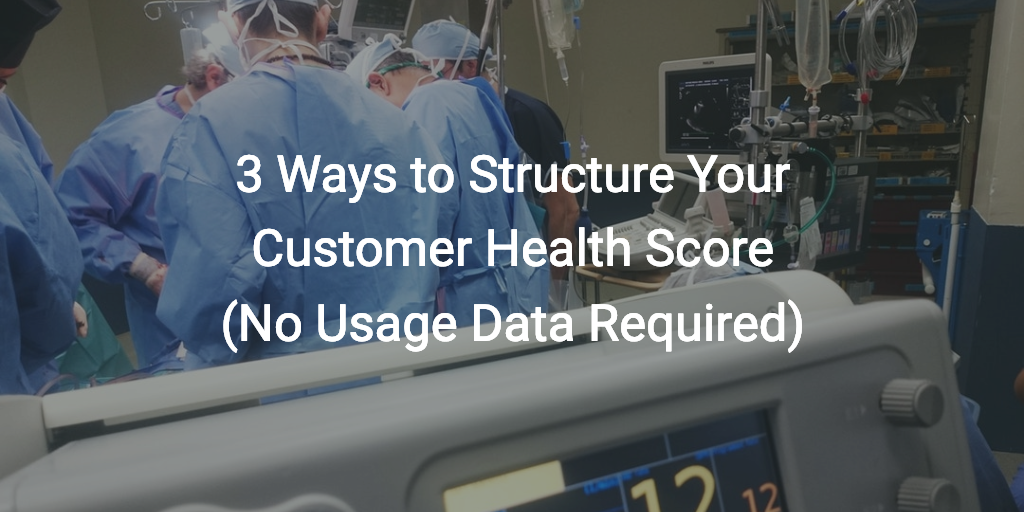When I think about health scores, it’s hard not to picture the analogy that’s built into the name: health.
In the health analogy, customers are like patients and Customer Success Managers (CSMs) are like doctors. CSMs do tests and measure signals to diagnose any “diseases” and prescribe the right treatment to reduce risk and improve customer outcomes. Fun fact—the healthcare economy has been increasingly thinking about patient outcomes not just as a programmatic way to benchmark how care providers are performing, but even as a way to think about billing and control costs.
But let’s take that healthcare analogy a bit further (too far, probably). Your doctor has all sorts of ways to understand, diagnose, and treat your health. But imagine if they only were taking your blood pressure?
That’s the trap we get into—especially in SaaS. We can become overreliant on usage data to the extent that some companies overlook other signals. Outside of SaaS, some companies assume they can’t “do” customer success without usage data and end up underinvesting in their customer base.
I interviewed three of our customers to find out how they were thinking about health scoring, and each gave me a dramatically different model based on their business needs. I wanted to outline them for you in a blog, because each offers up a unique approach health scoring, and none are completely dependent on real-time usage data.
Model 1: Consumption as Usage
This customer has an interesting health scoring model, because it does include a “usage” factor, but because their product is consumption based, it’s not necessarily meant in the same way that most people think about the word usage. In this company’s go-to-market, you purchase up front, draw down, and purchase again. If you have a product that is consumed and payed for on a credit system, for example, you can include those metrics as a stand-in for usage in your health score. In their case, the consumption is combined with percentage deployment to create an effective measurement of usage—without actually needing to granularly track it in-product, feature by feature.
The other three factors of this health score are a Relationship measurement, Propensity, and Breadth & Depth. Relationship is a survey-based metric that replaces NPS. It’s essentially a Customer Happiness Index based on the question, “On a scale of 1-10, how happy are you with us?” They also ask as a follow-up, “What three things can we do to fix it right now?”
Propensity is a vector that measures product engagement through enhancement requests and support tickets. They used to consider these as a negative indicator, but now they recognize that support and enhancement requests can be a sign of positive engagement (as long as there’s not too many).
Breadth & Depth, again, sounds like usage, but it’s really a measurement of a threshold of different products that are owned combined with whether or not the customer is leveraging Managed Services.
Takeaways
Stereotypical usage data isn’t always the best way to measure health. You can get started with a health score using nothing but data your Sales and Support teams are already collecting.
Model 2: Automation and Scale
This customer has two health scores—one for high-touch, CS-managed accounts, and one for non-CS-managed accounts. I’d love to drill down on the second one to highlight some interesting things they’re is doing with automation.
Their automated score is tracking Marketing engagement data, Support engagement—they had a similar “a-ha” moment with regards to a lack of tickets correlating to risk—Buyer Behavior (upsell, downsell, payment status), Sentiment (mainly NPS), Implementation, and Company.
Let’s focus on Implementation and Company. The Company score tracks segmentation and demographic info. This was another “a-ha” moment for this customer, because initially, they didn’t believe that non-standard buyers were less healthy than typical ones. The view was once a company purchased, they were more or less the same as core buyers. But they tested it and the data showed pretty clearly there needed to be a demographic and segmentation vector of the health score.
With regard to Implementation, they look at whether a customer has bought professional services or training and uses it as a proxy for a more direct implementation measurement. It’s another way of getting around issues of direct access. Like I said, this is all automated inside Gainsight, and as such it’s incredibly scalable.
Takeaways
This customer had a very smart template for how they chose their health score components:
- Does this data change?
- Does it correlate to churn/growth?
- Is the data clean?
- Is the data accessible?
- Is it easy to understand?
I want to highlight this because I think it’s very important. In order for data to drive decision making and action, it needs to be understood and believed. This is especially true in a high-touch environment. If you have thousands of customers (or millions in a B2C play), AI and machine learning can be black boxes if they’re accurate. When the the amount of data is not statistically significant, then buy-in from the larger org and leadership is critical for it to add value. And if people don’t easily understand it, they will not buy in.
Model 3: Driving Action vs. Forecasting Churn
The majority of this customer’s business model is on-premise, which means there’s no access to usage data. But they have a really good perspective on health scoring. They recognized that there’s not necessarily a perfect health score—you’re always going to be iterating and improving. Each of these companies (and Gainsight as well) has had assumptions challenged and made changes to improve their scores. But the important thing is that health scores are supposed to drive action. The goal isn’t really perfect forecasting, it’s providing a warning system to drive positive retention and growth.
This customer’s health score is a combination of subjective measures (a CSM score and a Partner score—a lot of their business flows through partners) and objective measures. Finance metrics, support cases, product requests, product status, and version are tracked as part of this vector. Even though it gives their team trend information and cross-functional visibility into the customer base, it’s also helped drive a customer success mentality at the company.
Takeaways
There are three key pieces of advice this customer had for me when I talked to them:
- Just because you can measure something, doesn’t mean you should include it in your health score. If it’s not meaningful, actionable, and applicable consistently across your customers, leave it out.
- Just get started. You don’t need perfect data or usage data. You have signals, and you can get started on using them today. The important thing is taking action and building a culture of customer success.
- Don’t include too many variables. A simple score is easier to benchmark against over time, and it cuts down on the noise as you test which signals are meaningful and in what ways.

